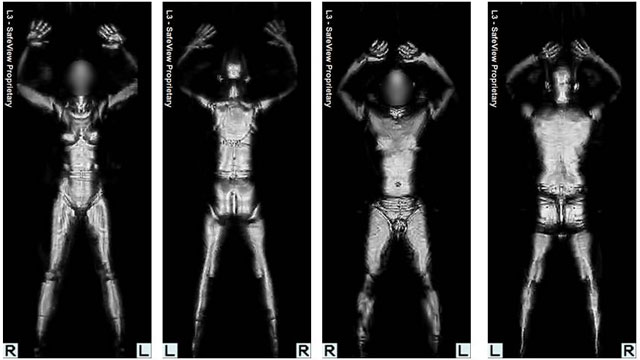Wednesday, November 24, 2010
FDA sidesteps safety concerns over TSA body scanners
The United States Transportation Security Administration has recently come under scrutiny for, among other things, its use of X-ray full-body scanners in airports to see through clothes and to detect non-metallic explosives. But are they safe? A group of UC-San Francisco professors recently raised a number of safety concerns regarding these scanners. While the Obama administration attempted to address these worries, its assertion that the scanners are safe appears to fall short.
The TSA has slowly been implementing the use of X-ray scanners in airports (so far, 38 airports have 206 of the machines) in order to see through passengers' clothes and check them for explosive devices. Officials have asserted that the machines are okay to use on the basis of the everyday use of X-rays in medical offices. However, a group of four UCSF professors pinpointed several important differences between the medical X-ray machines and those used in airports. They described the issues in a letter to Dr. John P. Holdren, the assistant to the president for science and technology.
A normal X-ray image is a familiar sight—depending on the exposure, an X-rayed person typically appears only as a skeleton. This is because the X-rays used in those machines penetrate the skin and can only scatter off of the larger atoms in bones.
Unlike a medical X-ray, the TSA X-ray machines are a sci-fi fan's dream: they are lower-energy beams that can only penetrate clothing and the topmost layers of skin. This provides TSA agents with a view that would expose any explosives concealed by clothing. But according to the UCSF professors, the low-energy rays do a "Compton scatter" off tissue layers just under the skin, rather than the bone, possibly exposing some vital areas and leaving the tissues at risk of mutation.
When an X-ray Compton scatters, it doesn't shift an electron to a higher energy level; instead, it hits the electron hard enough to dislodge it from its atom. The authors note that this process is "likely breaking bonds," which could cause mutations in cells and raise the risk of cancer.
Because the X-rays only make it just under the skin's surface, the total volume of tissue responsible for absorbing the radiation is fairly small. The professors point out that many body parts that are particularly susceptible to cancer are just under the surface, such as breast tissue and testicles. They are also concerned with those over 65, as well as children, being exposed to the X-rays.
The professors pointed to a number of other issues, including the possibility that TSA agents may scan certain areas more slowly (for example, the groin, to prevent another "underwear bomber" incident like the one in December 2009), exposing that area to even more radiation. But the letter never explicitly accuses the machines of being dangerous; rather, the professors encourage Dr. Holdren to pursue testing to make sure that the casual use of these X-rays is safe.
Dr. Holdren passed the letter on to the Food and Drug Administration for review. But, in the FDA's response, the agency gave the issues little more than a data-driven brush off. They cite five studies in response to the professors' request for independent verification of the safety of these X-rays; however, three are more than a decade old, and none of them deal specifically with the low-energy X-rays the professors are concerned about. The letter also doesn't mention the FDA's own classification of X-rays as carcinogens in 2005.
The letter concludes that "the potential health risks from a full-body screening with a general-use X-ray security system are minuscule." But the increased surface area and volume of absorption area, plus the frequency with which many people travel, suggests that this use at least bears further scrutiny. US pilots' associations have also encouraged their members to opt for the pat-down in the meantime.
Of course, these pat-downs have recently become rather invasive, so now travelers must choose between a little irradiation and being felt up by a non-doctor.
However, the TSA does have a potential solution in hand. Of the 68 airports scanning for explosives, 30 are using millimeter-wave scanners that don't use X-rays at all; they hit the surface of the body with safer radio waves. If the TSA committed to using only this type of equipment, it could avoid the safety concerns regarding the X-ray full body scanners completely.
Source
Subscribe to:
Post Comments (Atom)


No comments:
Post a Comment